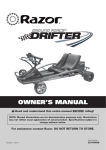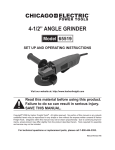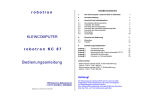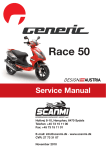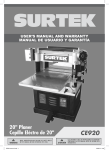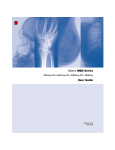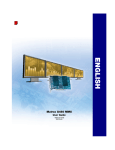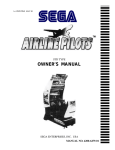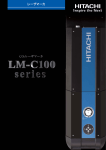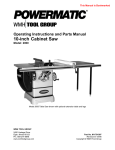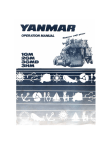Download Harbor Freight Tools 98198 User's Manual
Transcript
18" DRUM SANDER 98198 Set up And Operating Instructions Distributed exclusively by Harbor Freight Tools®. 3491 Mission Oaks Blvd., Camarillo, CA 93011 Visit our website at: http://www.harborfreight.com Read this material before using this product. Failure to do so can result in serious injury. Save this manual. Copyright© 2008 by Harbor Freight Tools®. All rights reserved. No portion of this manual or any artwork contained herein may be reproduced in any shape or form without the express written consent of Harbor Freight Tools. Diagrams within this manual may not be drawn proportionally. Due to continuing improvements, actual product may differ slightly from the product described herein. For technical questions or replacement parts, please call 1-800-444-3353. Contents Pulley Alignment���������������������� 16 Important SAFETY Information���������������������������� 3 Feed Belt Replacement���������� 17 General Power Tool Safety Warnings���������������������� 3 Drum Sanding OperationSafety Warnings� 5 Grounding��������������������������������� 7 Grounded Tools: Tools with Three Prong Plugs������� 7 Double Insulated Tools: Tools with Two Prong Plugs���������������������������������������������7 Feed Belt Tracking������������������ 16 Conveyor Table Adjustments���������������������������� 17 Troubleshooting���������������������� 20 V-Belts�������������������������������������������25 Bearings��������������������������������������� 25 ASSEMBLY DIAGRAM���������������� 26 Limited 1 year / 90 Day warranty������������������������������ 27 Extension Cords������������������������� 8 Symbology������������������������������������� 8 Specifications�������������������������� 9 Unpacking���������������������������������� 9 List of contents�������������������������� 9 Instructions for putting into use������������������������������������ 9 Assembly���������������������������������������� 9 Mounting���������������������������������������10 Final Assembly��������������������������� 10 Operating Instructions���� 10 Tool Set Up���������������������������������� 10 Work Piece and Work Area Set Up������������������������������������������ 11 General Operating Instructions���������������������������� 11 Maintenance And Servicing������������������������������� 15 Cleaning and Maintenance��� 15 Replacing V-belts��������������������� 16 SKU 98198 For technical questions, please call 1-800-444-3353. Page 2 NOTICE is used to address practices not related to personal injury. Save This Manual Keep this manual for the safety warnings and precautions, assembly, operating, inspection, maintenance and cleaning procedures. Write the product’s serial number in the back of the manual near the assembly diagram (or month and year of purchase if product has no number). Keep this manual and the receipt in a safe and dry place for future reference. CAUTION, without the safety alert symbol, is used to address practices not related to personal injury. General Power Tool Safety Warnings Important SAFETY Information WARNING Read all safety warnings and instructions. Failure to follow the warnings and instructions may result in electric shock, fire and/or serious injury. Save all warnings and instructions for future reference. The term ″power tool″ in the warnings refers to your mainsoperated (corded) power tool or battery-operated (cordless) power tool. In this manual, on the labeling, and all other information provided with this product: This is the safety alert symbol. It is used to alert you to potential personal injury hazards. Obey all safety messages that follow this symbol to avoid possible injury or death. 1. a.Keep work area clean and well lit. Cluttered or dark areas invite accidents. DANGER indicates a hazardous situation which, if not avoided, will result in death or serious injury. b.Do not operate power tools in explosive atmospheres, such as in the presence of flammable liquids, gases or dust. Power tools create sparks which may ignite the dust or fumes. WARNING indicates a hazardous situation which, if not avoided, could result in death or serious injury. CAUTION, used with the safety alert symbol, indicates a hazardous situation which, if not avoided, could result in minor or moderate injury. SKU 98198 Work area safety c.Keep children and bystanders away while operating a power tool. Distractions can cause you to lose control. 2. Electrical safety a.Power tool plugs must match the outlet. Never modify the plug in any way. Do not use any adapter For technical questions, please call 1-800-444-3353. Page 3 plugs with grounded power tools. Unmodified plugs and matching outlets will reduce risk of electric shock. tion and full-face shield. Safety equipment such as dust mask, nonskid safety shoes, hard hat, or hearing protection used for appropriate conditions will reduce personal injuries. b.Avoid body contact with grounded surfaces such as pipes, radiators, ranges and refrigerators. There is an increased risk of electric shock if your body is grounded. c.Prevent unintentional starting. Ensure the switch is in the off-position before connecting to power source, picking up or carrying the tool. Carrying power tools with your finger on the switch or energizing power tools that have the switch on invites accidents. c.Do not expose power tools to rain or wet conditions. Water entering a power tool will increase the risk of electric shock. d.Do not abuse the cord. Never use the cord for carrying, pulling or unplugging the power tool. Keep cord away from heat, oil, sharp edges or moving parts. Damaged or entangled cords increase the risk of electric shock. d.Remove any adjusting key or wrench before turning the power tool on. A wrench or a key left attached to a rotating part of the power tool may result in personal injury. e.Do not overreach. Keep proper footing and balance at all times. This enables better control of the power tool in unexpected situations. e.When operating a power tool outdoors, use an extension cord suitable for outdoor use. Use of a cord suitable for outdoor use reduces the risk of electric shock. f. Dress properly. Do not wear loose clothing or jewelry. Keep your hair, clothing and gloves away from moving parts. Loose clothes, jewelry or long hair can be caught in moving parts. f. If operating a power tool in a damp location is unavoidable, use a Ground Fault Circuit Interrupter (GFCI) protected supply. Use of a GFCI reduces the risk of electric shock. 3. g.If devices are provided for the connection of dust extraction and collection facilities, ensure these are connected and properly used. Use of these devices can reduce dustrelated hazards. Personal safety a.Stay alert, watch what you are doing and use common sense when operating a power tool. Do not use a power tool while you are tired or under the influence of drugs, alcohol or medication. A moment of inattention while operating power tools may result in serious personal injury. b.Use safety equipment. Always wear ANSI-approved eye protec- SKU 98198 4. Power tool use and care a.Do not force the power tool. Use the correct power tool for your application. The correct power tool will do the job better and safer at the rate for which it was designed. For technical questions, please call 1-800-444-3353. Page 4 b.Do not use the power tool if the switch does not turn it on and off. Any power tool that cannot be controlled with the switch is dangerous and must be repaired. c.Disconnect the plug from the power source and/or the battery pack from the power tool before making any adjustments, changing accessories, or storing power tools. Such preventive safety measures reduce the risk of starting the power tool accidentally. d.Store idle power tools out of the reach of children and do not allow persons unfamiliar with the power tool or these instructions to operate the power tool. Power tools are dangerous in the hands of untrained users. e.Maintain power tools. Check for misalignment or binding of moving parts, breakage of parts and any other condition that may affect the power tool’s operation. If damaged, have the power tool repaired before use. Many accidents are caused by poorly maintained power tools. f. Keep cutting tools sharp and clean. Properly maintained cutting tools with sharp cutting edges are less likely to bind and are easier to control. g.Use the power tool and accessories in accordance with these instructions, taking into account the working conditions and the work to be performed. Use of the power tool for operations different from those intended could result in a hazardous situation. SKU 98198 5. Service a.Have your power tool serviced by a qualified repair person using only identical replacement parts. This will ensure that the safety of the power tool is maintained. Drum Sanding Operation Safety Warnings 1. This power tool is intended to function as a wood sander. Read all safety warnings, instructions, illustrations and specifications provided with this power tool. Failure to follow all instructions listed below may result in electric shock, fire and/ or serious injury. 2. Operations such as grinding, wire brushing or polishing are not recommended to be performed with this power tool. Operations for which the power tool was not designed may create a hazard and cause personal injury. 3. Do not use accessories which are not specifically designed and recommended by the tool manufacturer. Just because the accessory can be attached to your power tool, it does not assure safe operation. 4. Wear personal protective equipment. Depending on application, use face shield or safety glasses. As appropriate, wear dust mask, hearing protectors, gloves and workshop apron capable of stopping small abrasive or work piece fragments. The eye protection must be capable of stopping flying debris generated by various operations. The dust mask or respirator must be capable of filtrating particles For technical questions, please call 1-800-444-3353. Page 5 generated by your operation. Prolonged exposure to high intensity noise may cause hearing loss. 5. Keep bystanders a safe distance away from work area. Anyone entering the work area must wear personal protective equipment. Fragments of work piece or of a broken accessory may fly away and cause injury beyond immediate area of operation. 6. Position the cord clear of the spinning accessory. If you lose control, the cord may be cut or snagged and your hand or arm may be pulled into the spinning accessory. 7. Maintain labels and nameplates on the tool. These carry important safety information. If unreadable or missing, contact Harbor Freight Tools for a replacement. 8. Avoid unintentional starting. Prepare to begin work before turning on the tool. 9. This product is not a toy. Keep it out of reach of children. 10. People with pacemakers should consult their physician(s) before use. Electromagnetic fields in close proximity to heart pacemaker could cause pacemaker interference or pacemaker failure. In addition, people with pacemakers should: • Avoid operating alone. • Do not use with power switch locked on. • Properly maintain and inspect to avoid electrical shock. • Any power cord must be properly grounded. Ground Fault Circuit Interrupter (GFCI) should also be impleSKU 98198 mented – it prevents sustained electrical shock. 11. Some dust created by power sanding wood products can contain chemicals known [to the State of California] to cause cancer, birth defects or other reproductive harm such as specially treated wood, wood with lead paint in it, and some species of wood have toxic qualities. Some examples of these chemicals are: • Lead from lead-based paints • Arsenic and chromium from chemically treated lumber Your risk from these exposures varies, depending on how often you do this type of work. To reduce your exposure to these chemicals: work in a well ventilated area, and work with approved safety equipment, such as those dust masks or respirators that are specially designed to filter out microscopic particles. (California Health & Safety Code § 25249.5, et seq.) 12. WARNING: Handling the cord on this product will expose you to lead, a chemical known to the State of California to cause cancer, and birth defects or other reproductive harm. Wash hands after handling. (California Health & Safety Code § 25249.5, et seq.) 13. The warnings, precautions, and instructions discussed in this instruction manual cannot cover all possible conditions and situations that may occur. It must be understood by the operator that common sense and caution are factors which cannot be built into this product, but must be supplied by the operator. For technical questions, please call 1-800-444-3353. Page 6 Save these instructions. three prong grounding plug. The plug must be connected to a properly grounded outlet. If the tool should electrically malfunction or break down, grounding provides a low resistance path to carry electricity away from the user, reducing the risk of electric shock. (See 3-Prong Plug and Outlet.) Grounding To prevent electric shock and death from incorrect grounding wire connection: Check with a qualified electrician if you are in doubt as to whether the outlet is properly grounded. Do not modify the power cord plug provided with the tool. Never remove the grounding prong from the plug. Do not use the tool if the power cord or plug is damaged. If damaged, have it repaired by a service facility before use. If the plug will not fit the outlet, have a proper outlet installed by a qualified electrician. 3. The grounding prong in the plug is connected through the green wire inside the cord to the grounding system in the tool. The green wire in the cord must be the only wire connected to the tool’s grounding system and must never be attached to an electrically “live” terminal. (See 3-Prong Plug and Outlet.) 4. The tool must be plugged into an appropriate outlet, properly installed and grounded in accordance with all codes and ordinances. The plug and outlet should look like those in the preceding illustration. (See 3-Prong Plug and Outlet.) Grounded Tools: Tools with Three Prong Plugs 1. This Drum Sander comes with a three prong plug. 2. Tools marked with “Grounding Required” have a three wire cord and SKU 98198 Double Insulated Tools: Tools with Two Prong Plugs 1. Tools marked “Double Insulated” do not require grounding. They have a special double insulation system which satisfies OSHA requirements and complies with the applicable For technical questions, please call 1-800-444-3353. Page 7 6. Make sure the extension cord is properly wired and in good electrical condition. Always replace a damaged extension cord or have it repaired by a qualified electrician before using it. Double insulated tools may be used in either of the 120 volt outlets shown in the preceding illustration. (See Outlets for 2-Prong Plug.) 7. Protect the extension cords from sharp objects, excessive heat, and damp or wet areas. 3. 4. 5. (at full load) 0 – 2.0 18 18 18 18 16 2.1 – 3.4 18 18 18 16 14 3.5 – 5.0 18 18 16 14 12 5.1 – 7.0 18 16 14 12 12 7.1 – 12.0 18 14 12 10 - 12.1 – 16.0 14 12 10 - - 16.1 – 20.0 12 10 - - - TABLE A * Based on limiting the line voltage drop to five volts at 150% of the rated amperes. Symbology Double Insulated When using more than one extension cord to make up the total length, make sure each cord contains at least the minimum wire size required. (See Table A.) If you are using one extension cord for more than one tool, add the nameplate amperes and use the sum to determine the required minimum cord size. (See Table A.) If you are using an extension cord outdoors, make sure it is marked with the suffix “W-A” (“W” in Canada) to indicate it is acceptable for outdoor use. SKU 98198 EXTENSION CORD LENGTH 150’ As the distance from the supply outlet increases, you must use a heavier gauge extension cord. Using extension cords with inadequately sized wire causes a serious drop in voltage, resulting in loss of power and possible tool damage. (See Table A.) The smaller the gauge number of the wire, the greater the capacity of the cord. For example, a 14 gauge cord can carry a higher current than a 16 gauge cord. (See Table A.) NAMEPLATE AMPERES 100’ 2. Grounded tools require a three wire extension cord. Double Insulated tools can use either a two or three wire extension cord. 75’ 1. (120/240 VOLT) 50’ Extension Cords RECOMMENDED MINIMUM WIRE GAUGE FOR EXTENSION CORDS* 25’ 2. standards of Underwriters Laboratories, Inc., the Canadian Standard Association, and the National Electrical Code. (See Outlets for 2-Prong Plug.) Canadian Standards Association Underwriters Laboratories, Inc. V~ A Volts Alternating Current Amperes No Load Revolutions per Minute n0 xxxx/min. (RPM) For technical questions, please call 1-800-444-3353. Page 8 subheadings therein before set up or use of this product. Specifications Maximum Stock Width 18" (36” two passes) Sanding Motor 1-1/2 HP Single Phase, Fan Cooled Induction Motor Stock Thickness Range 1/8" to 4-1/2" Electrical Requirements 120 V~ / 60 Hz / 15A Sanding Drum Speed 4,000 RPM Dust Collection 2-1/2" Port & Built-In fan Conveyor Belt speed Range from 2 - 12 FPM Net Weight 300 LBS Assembly When unpacking, check to make sure that the item is intact and undamaged. If any parts are missing or broken, please call Harbor Freight Tools at the number shown on the cover of this manual as soon as possible. List of contents Description Some tools may not be supplied The Drum Sander. a.The Drum Sander comes 95% preassembled. Assemble the stand. a.It is easier to assemble upside down. Stand Leg (263) Qty 1 1 1 1 3 1 Instructions for putting into use Read the entire Important Safety Information section at the beginning of this manual including all text under SKU 98198 To prevent serious injury from accidental operation: Turn the Power Switch of the tool to its “OFF” position and unplug the tool from its electrical outlet before assembling or making any adjustments to the tool. Note: For additional information regarding the parts listed in the following pages, refer to the Assembly Diagram near the end of this manual. Unpacking Drum Sander - Pre-assembled Dust Bag (273) Dust Hose Collar (218) Square Dust Port (56) Hex Key 4mm, 5mm, 6mm Double Open-End Wrench Lower Long Bracket (266) Upper Long Bracket (264) Fig. 1 b.Mount an Upper (264) and Lower Long Bracket (266) to a Stand Leg (263) and loosely attach (See Fig. 1) For technical questions, please call 1-800-444-3353. Page 9 with two M8-1.25 x 15 Carriage Bolts (268) and Flanged Nuts (269). c. Do not tighten the screws to the Stand until its assembly is complete. Final Assembly Attach components. a.Screw the Hand Wheel Handle onto the Hand Wheel (103). b.Attach Hand Wheel (103) with a Hex Socket HD Screw (239) and Flat Washer (238). Completed Stand c. Attach the Square Dust Port (56). d.Attach the Square-To-Round Dust Chute (59) Adapter and Dust Chute (70). e.Attach the Dust Bag (273). Fig. 2. Operating Instructions Read the entire Important Safety Information section at the beginning of this manual including all text under subheadings therein before set up or use of this product. d.Repeat this assembly process with the other three legs, using the supplied hardware, until the Stand (263) assembly is complete. (See Fig. 2.) Mounting Tool Set Up Attach drum sander to stand. To prevent serious injury from accidental operation: Turn the Power Switch of the tool to its “OFF” position and unplug the tool from its electrical outlet before performing any inspection, maintenance, or cleaning procedures. a.Lay the Drum Sander on its side with the Hand Wheel (103) facing up. b.With the Stand (263) on its side, point the Stand’s top toward the sander’s bottom, c. Move the Stand up against the bottom of the sander and align holes. d.Bolt the Sander to the Stand using Hex Bolts (270)/Hex Nuts (271)/Flat Washers (272) in four places. e.With bolts securely tightened and the help of another person, tilt the Drum Sander/Stand upright. 1. The initial setup and adjustment of the following have been done at the factory: a.V-Belt tensioning. b.Feed Belt tensioning and tracking. c. Table adjustments. SKU 98198 For technical questions, please call 1-800-444-3353. Page 10 c. Place the stock on the Conveyor Table (137) and raise the Conveyor Table until it is just a little below the sanding roller. Work Piece and Work Area Set Up 1. 2. Designate a work area that is clean and well-lit. The work area must not allow access by children or pets to prevent injury and distraction. Route the power cord along a safe route to reach the work area without creating a tripping hazard or exposing the power cord to possible damage. The power cord must reach the work area with enough extra length to allow free movement while working. General Operating Instructions 1. d.Be sure the dust collection system is already in place. (See “Dust Bag” below. Wear ANSI-Approved safety goggles and heavy duty gloves during use. 2. Wear a good respirator breathing device. 3. To prevent accidents, turn off the tool and disconnect its power supply after use. Clean, then store the tool indoors out of childrens’ reach. 4. Generally, when using this machine you will stand at the “open” side and feed the stock. The stock will be placed on the Conveyor Table on the left (infeed) and will travel to the right (outfeed). Use roller supports for long stock. 5. Do not stand directly in front of the infeed or outfeed end in case stock is accidently ejected. 6. Depth of cut. a.Depth of cut will vary depending on type of wood, and sandpaper grit. b.Lower the conveyor table lower than necessary for the stock to be sanded to prevent the stock from being “grabbed” suddenly when the machine is turned on. SKU 98198 e.Plug in and start the Drum Sander, then begin raising the Conveyor Table height while feeding the stock on the Conveyor Belt (165). f. Turning the Hand Wheel (103) 1/4 turn, is the most that is recommended at any one time. 7. Dust Bag. Square Dust Port (56) Fig. Square Dust Port a.The Dust Port Assembly should be mounted in place at this time. (See Attach Components c, d, e of “Final Assembly”. b.The Dust Port Assembly is composed of: • Square Dust Port (56) • Square-to-Round Dust Chute (59) • Dust Chute (70). (See the assembly drawing at the end of this manual.) For technical questions, please call 1-800-444-3353. Page 11 Dust Bag (273) Grit Class 120-180 Fine Usage Finishing a.When changing grit, do not change by greater than a value of 50. 11. Sandpaper replacement. Dust Bag c.The Dust Bag (273) is secured to the Dust Chute (70) with a Collar (218). 8. Speed adjustment. a.The speed of the Feed Belt (165) is adjusted by turning the Speed Adjustment Knob (74) while the machine is running. b.Turn the knob counterclockwise to increase the feed speed, clockwise to slow it down. 9. Sanding tips. a.If the stock is bowed, run it through with the high point on top and use light cuts. b.Feeding with the grain at an angle to feed direction will sand faster but for a finer finish, feed so direction of travel is straight with the grain. c. When done, turn Power Switch (105) off and unplug the power cord. 10. Sandpaper grit selection chart. Grit Class 36 Extra Course 60 Course 80-100 Medium SKU 98198 Usage Rough sawn boards, thicknessing and glue removal Thicknessing and glue removal Removing sanding marks and initial finishing a.Tools supplied: • Hex keys - 4mm, 6mm • Double open end wrench - 8mm, 12mm • The Drum Sander comes with 80 grit sandpaper on the Drum (178) and a 150 grit Feed Belt (165). b.Tools not supplied: • Flat-end screwdriver • Hex keys - 5mm, 8mm • Roll of 3” wide sand paper • Utility knife to cut sand paper c. Disconnect the sander. d.Open the Head Cover (186) and remove the three Hex Soc HD Scr (200) holding the Deflector Shield (187) and set aside. e.The Sandpaper (179) is removed from the Drum (178) from right to left, and replaced from left to right. f. Loosen the spring-loaded Locking Block (173) on the right by unscrewing the Hex Soc HD Scr (172) and use a screwdriver to loosen the Locking Block (173). g.Remove the Sandpaper (179) from under the Locking Block and start unrolling it from right toward the left. h.Loosen the left Locking Block (173). i. Remove the old Sandpaper (179) carefully. This old sandpaper will be used as a template for the new one. j. It would be advisable to save the sandpaper removed for this first change so it can be used for each subsequent replacements. Thus the For technical questions, please call 1-800-444-3353. Page 12 size and shape of the template will not change over time. Sandpaper 3" Sandpaper (179) k.After cutting the 12-1/2" angled sides, cut 1" from the greater length edge of both ends of the sandpaper strip as shown above. l. Place the left side of the new sandpaper under the left Locking Block (173) and tighten. The left side of the sandpaper must be flush with the Drum (178) edge (not over hanging). m.Start wrapping the sandpaper around the Drum so there are no air bubbles and no over-lapping edges. n.When reaching the right side, move the sandpaper out of the way, and position the 4mm hex wrench into the top of the Hex Soc HD Scr. o.Place the end of the sandpaper under the Locking Block and tighten the Hex Soc HD Scr (172). p.If the sandpaper does not line up properly when reaching the righthand side. unwrap and repeat. q.Reinstall the Deflector Shield (187) and secure with the three Hex Soc HD Scr (172), and close the cover. 12. Cleaning the machine. b.These bushings (135) requiring oiling are located at each end of the Feed Belt Rollers (136, 156). Also, remove the Side Cover (82) and oil the drive bushings (29) as needed. c.Apply Lithium grease to all moving parts. This includes gears, chains, Feed Belt Rollers (136, 156) and Table’s (137) lift mechanism. d.The moving and rotating parts of the Table’s (137) lift mechanism including its Elevating Screws (162) must be cleaned free of old grease and fresh lithium grease applied as needed. e.Clean the teeth of the rotating helicalcut gear (113) and add fresh lithium grease. Raising and lowering the Table (137) spreads the grease to all rubbing parts. 14. Sanding Belts. a.Extend the life of the sand paper by using a crepe sanding pad (cleans build-up off the sandpaper) to remove material build-up. 15. V-Belt Tensioning. Drive V-Belt 1/2" to 3/4" deflection a.Cleanup consists of vacuuming the various exterior and interior (hidden) areas of the sander. 13. Lubrication. a.Feed Bushings (135) need to be lubricated on a daily basis or with each use. SKU 98198 V-Belts a.Correct V-Belt tension is when the V-Belt can be deflected 1/2" - 3/4". For technical questions, please call 1-800-444-3353. Page 13 Test by pressing in the middle with a moderate amount of force. b.Turn off the sander and un-plug the power cord. c. Remove the pulley/V-Belt Side Cover (82). d.Check the V-Belts for signs of wear, deterioration or cracking. If any signs are visible, replace with a new belt. e.The Feed V-belt (99) is tensioned by loosening the Motor Bracket (100) screws and sliding the motor downward to tighten the V-Belt. f. The Drive V-Belt (97) is tensioned by pressing the tensioner Roller (255) against the V-belt, increasing pressure until the V-belt is of proper tension. g.These V-Belts are subject to stretching and loosening, so they must be checked on a regular basis and tensioned whenever necessary. h.Replace the pulley/V-Belt Side Cover (82). SKU 98198 For technical questions, please call 1-800-444-3353. Page 14 Maintenance And Servicing Dust Bag Procedures not specifically explained in this manual must be performed only by a qualified technician. To prevent serious injury from accidental operation: Turn the Power Switch of the tool to its “OFF” position and unplug the tool from its electrical outlet before performing any inspection, maintenance, or cleaning procedures. To prevent serious injury from tool failure: Do not use damaged equipment. If abnormal noise or vibration occurs, have the problem corrected before further use. Dust Bag 3. If a dust collector is not used, clean out the Dust Bag (273) on a regular basis. (See Fig. “Dust Bag”) The frequency required will depend on hours of use, the type of stock being sanded, and the grit of sandpaper being used. 4. WARNING! If the power cord of this power tool is damaged, it must be replaced only by a qualified service technician. Cleaning and Maintenance 1. BEFORE EACH USE, inspect the general condition of the tool. Check for loose screws, misalignment or binding of moving parts, cracked or broken parts, damaged electrical wiring, and any other condition that may affect its safe operation. 2. After Use, Brush and wipe external surfaces of the tool and vacuum if possible. SKU 98198 For technical questions, please call 1-800-444-3353. Page 15 Replacing V-belts 1. Disconnect the Drum Sander from the electrical outlet. 2. Open the Side Cover (82). 3. To replace the variable-speed Drive Belt (97), loosen the cap screw securing the variable-speed Pulley (26, 28) before loosening the motor mount cap screws. 2. Open the Pulley Cover (108). 3. If possible put a straightedge against the pulley faces or sight downward across the motor pulley and the feed pulley. 4. If the pulleys are not aligned on the same plane, one of them needs to be adjusted. 5. Moving a pulley requires removal of the V-belts. 4. Loosen the motor mount cap screws and the Pan Head screw (257) securing the tensioner roller. 5. Remove the cap screws securing the Bearing Bracket (6) and rotate the Bearing Bracket 90°. b.Tighten the set screws, replace the V-belts, and recheck alignment again. 6. Lift the motor, with a pry bar if necessary. 7. To replace the variable-speed Drive Belt (97), remove the Hex Soc Hd Scr (16) securing the pulley, and remove the outer half of the pulley (26). c. If the Sanding Belt Pulley (43) needs to be aligned, loosen its Set Screw and adjust until it too is aligned with the Motor Pulley (98). 8. 9. Compress the Spring (20) behind the inner half of the Variable Speed Pulley (19). Slide the outer half of the pulley over the shaft (23) and Key (31) and thread in the Hex Soc Hd Scr. Install new Feed (99) and Drive V-belts (97), re-attach the Bearing Bracket, and tension according to instructions. 10. Tighten the variable speed pulley cap screw and replace the Side Cover (82). Pulley Alignment 1. Disconnect Drum Sander from the electrical outlet. SKU 98198 a.Loosen the Set Screw on the Motor Pulley and align the Motor Pulley with the Feed Belt Pulley. d.Repeat the adjustments until the pulley pairs are on the same plane with each other. e.Replace the Pulley Cover (108). Feed Belt Tracking Feed belt tracking adjustment is a process taking trial-and-error to perform. 1. Turn the Feed Belt (165) “ON” and observe the tracking. If the feed belt moves to one side or the other, stop the belt immediately. 2. If the Feed Belt tracks toward one side, loosen the lock nut on that side and tension the adjustment screw until the belt tracks in the opposite direction. If the belt continues to track to one side, turn the Drum Sander For technical questions, please call 1-800-444-3353. Page 16 off and perform tracking adjustment again. 3. The belt should no longer move to one side during continuous use. The Conveyor Table (137) should not move up or back and forth 4. Do not over tighten the Feed Belt. 5. Lock the Feed Belt tensioning bolts by tightening the lock nuts. Conveyor Table Adjustments 1. Disconnect the power cord from the electrical outlet. 2. Remove the sandpaper from the drum and place previously prepared gauge blocks at either side of the Feed Belt (165). a.Gauge blocks are prepared by taking two 2" x 4"s and jointing one side of each until the sides are absolutely flat. Feed Belt Replacement 1. Disconnect the Drum Sander. 2. Mark the front of the Feed Belt tensioning bolt with a crayon or marker of some kind so that it can be replaced to its original position. 3. Loosen the lock nuts and turn both feed belt adjustment bolts counterclockwise a full turn at a time to release tension. 4. Remove the outside cap screws and loosen the corresponding cap screws on the inside edge. 5. 6. 7. 8. Have a helper lift the outside edge of the Conveyor Table (137) and slide the feed belt off. In reverse order, install a new feed belt after cleaning off the the Conveyor Table and its surrounding area. Re-install the Conveyor Table cap screws. Tighten the cap screws. Perform the previously explained tensioning and tracking procedures. Check for tension and tracking on a regular basis. SKU 98198 b.Place the jointed edge against a table saw fence and cut a little off the un-jointed edge. Repeat for the other block. c. This gives two gauge blocks that are exact in height. 3. With the gauge blocks in place, the distance from each end of the sanding Drum (178) to the Conveyor Table (137) should be the same. Adjust one side or the other until the distances are perfectly equal. 4. Raise the Conveyor Table until the gauge blocks just touch the Drum (178). a.Check rear of the Pressure Plate (84) adjustment: • Use feeler gauges. • If the gap is more than 0.004” the rear of the Pressure Plate (84) must be adjusted. b.Check front of the Pressure Plate adjustment: • Use feeler gauges. • If the gap is more than 0.004", the front of the Pressure Plate (84) must be adjusted. For technical questions, please call 1-800-444-3353. Page 17 5. To adjust the rear Pressure Plate: a.Disconnect the power cord from the outlet. b.Loosen the lock nuts and tighten the cap screws on both ends of the rear of the Pressure Plate (84) to raise or loosen to lower the plate. c. Adjust until the rear of the Pressure Plate (84) until it is at or up to 0.004” lower than the drum. To adjust the front of the Pressure Plate: d.Disconnect the Drum Sander. e.Loosen the lock nuts and tighten the cap screws on both ends of the front of the Pressure Plate to raise the plate or loosen to lower. f. Adjust until the front of the Pressure Plate is up to 0.004" lower than the drum. SKU 98198 For technical questions, please call 1-800-444-3353. Page 18 Wiring Diagram MOTOR Motor Thermal Circuit Breaker Start Capacitor 1 3 5 2 4 6 Power ON/OFF Switch 120V The colored wires connected to the motor are not specified because they are interchangeable. White Black Ground SKU 98198 For technical questions, please call 1-800-444-3353. Page 19 Troubleshooting Problem Possible Causes Likely Solutions 1. Plug/outlet faulty or wired wrong. 1. Test plug and outlet for good contact and correct wiring. 2. Start capacitor is faulty. 2. Test capacitor and replace if necessary. 3. Motor connection incorrectly 3. Correct motor wiring. wired. 4. Power supply is faulty, or is 4. Make sure hot lines and grounds are switched off. operational and have correct voltage on all Tool will not legs. start or trips the 5. Safety switch key is at fault. 5. Install or replace safety key, or replace switch breaker. assembly. 6. Motor ON/OFF switch faulty. 6. Replace faulty ON/OFF switch. 7. Centrifugal switch faulty. 7. Adjust or replace centrifugal switch. 8. Cable or wiring is open or has 8. Check for disconnected or corroded high resistance. connections, troubleshoot wires for internal or external breaks, then repair or replace wiring. 9. Motor is at fault. 9. Test, then repair or replace the motor. 1. Wiring workpiece material. 1. Only process wood with proper moisture content and having no glues or resins. 2. Low power supply voltage. 2. Ensure hot lines and grounds are operational and have correct voltage on all legs. 3. Run capacitor is faulty. 3. Test capacitor and replace if necessary. 4. Filter bags are at fault 4. Empty and clean filter bags. 5. V-belts are slipping. 5. Replace bad belts, align pulleys, and retension the V-belts. 6. Plug or outlet is at fault. 6. Test power plug and outlet for good contact and correct wiring. Machine stalls or is underpowered 7. Motor connections are wired 7. Correct motor wiring. (See Wiring Diagram incorrectly. Pg. 19.) 8. Motor bearings are at fault. 8. Rotate motor shaft for noisy or burnt bearing, repair/replace as required. 9. Motor has overloaded. 9. Use sandpaper of the proper grit and reduce the feed rate/depth of sanding. 10.Motor has overheated. 10.Check motor-cooling air flow, let motor cool and reduce workload on machine. 11.Centrifugal switch is at fault. 11.Adjust/replace centrifugal switch. 12.Motor is at fault. 12.Test motor and repair/replace if necessary. SKU 98198 For technical questions, please call 1-800-444-3353. Page 20 Troubleshooting Cont. Problem Possible Causes 1. Motor or component is loose. 2. V-belts are worn or loose. 3. Motor fan is rubbing on fan cover. 4. Pulley is loose. Likely Solutions 1. Inspect for stripped/damaged bolts/nuts, replace/re-tighten with thread locking fluid. 2. Inspect belts, replace and re-tension. 3. Replace dented fan cover/damaged fan. 4. Remove pulley, replace shaft, pulley, setscrew and key as required and realign. 5. Machine has loose anchor studs in floor, or is sitting on uneven floor. Replace/tighten or relocate as soon as required. 6. Cast-iron motor mount is at fault. 6. Using leverage and a small pry bar to inspect, carefully replace loose/broken mounts. 7. Motor bearings are at fault. 7. Check bearings, replace motor or bearings as required. Machine has vibration or noisy 5. Machine is incorrectly mounted operation. to the floor. Sanding Operations Problem Possible Causes Vibration when sanding Grinding, screeching, or rubbing noise when sanding drum is powered up. Short V-belt lifespan Machine lacks power; drum stops turning under load. Feed belt slips under load. Feed belt tracks to one side and hits the feed table mounts. Likely Solutions 1. Loose drum bearings (215) 2. Worn drum bearings (215) 1. Drum bearings lack sufficient oil. 2. Drum bushings (206) are worn and need replacing. 1. Tighten drum bearings. 2. Replace drum bearings. 1. Oil the drum bearings. 2. Replace the drum bushings. 1. Pulleys not aligned correctly. 2. Improperly tensioned. 1. V-belts are loose. 2. Too much pressure on pressure plate (84). 1. Align pulleys to be on same plane. 2. Properly tension V-belts. 1. Tighten V-belts 2. Raise the pressure plates. 1. Feed belt is too loose. 2. Too much load. 1. Feed belt tracking is incorrect. 1. Tension the V-belts. 2. Decrease the load. 1. Adjust feed belt tracking. 1. Lack of outfeed support. 1. Set up an outfeed table or have someone stand along open side of sander and retrieve the workpiece as it comes out. 2. Lower the Pressure Plate. Excessive snipe. 2. Too much pressure from Pressure Plate (84). 3. Too much pressure from the rear 3. Lower the rear of Pressure Plate. of pressure plate (84). Workpiece kicks 1. Not enough pressure from the 1. Raise the Pressure Plate. out of sander. pressure plate (84). SKU 98198 For technical questions, please call 1-800-444-3353. Page 21 Problem Possible Causes 1. Possibly a nail/staple in Sandpaper on workpiece. Drum tears during operation 2. Sandpaper not tightened or fastened correctly. 1. Table lift screws are dirty or loaded with sawdust. Table elevation controls are 2. Chain idler sprocket Cap Screws stiff and hard to have been over tightened. adjust. 3. Elevation handle helical gear is dirty or loaded with sawdust. Likely Solutions 1. Sand only clean workpieces. 2. Install the sandpaper correctly. 1. Clean and re-grease table lift screws. 2. Adjust the Cap Screws on the Idler Sprocket so it can rotate freely. 3. Clean and re-grease the Helical Cut Gear (113). Follow all safety precautions whenever diagnosing or servicing the tool. Disconnect power supply before service. PLEASE READ THE FOLLOWING CAREFULLY The manufacturer and/or distributor has provided the parts list and assembly diagram in this manual as a reference tool only. Neither the manufacturer or distributor makes any representation or warranty of any kind to the buyer that he or she is qualified to make any repairs to the product, or that he or she is qualified to replace any parts of the product. In fact, the manufacturer and/ or distributor expressly states that all repairs and parts replacements should be undertaken by certified and licensed technicians, and not by the buyer. The buyer assumes all risk and liability arising out of his or her repairs to the original product or replacement parts thereto, or arising out of his or her installation of replacement parts thereto. SKU 98198 For technical questions, please call 1-800-444-3353. Page 22 PART 1 2 3 4 5 6 7 8 9 10 11 12 13 14 15 16 17 18 19 20 21 22 23 24 25 26 27 28 29 30 31 32 33 34 35 36 37 38 39 40 41 42 43 44 45 46 PART NAME SPRING WASHER PAN HEAD SCREW FLAT WASHER HEX SOC HD SCR BEARING RETAINER BEARING BRACKET HEX SOC HD SCR CROSS PAN HEAD SCREW C-RING SPRING WASHER SPONGE STRIP SPONGE STRIP HEX WRENCH HEX WRENCH HEX WRENCH HEX SOC HD SCR FLAT WASHER PULLEY PULLEY SPRING SPACER BEARING(6003ZZ) SHAFT BEARING(6002ZZ) THRUST BALL BEARING(51105) PULLEY BELT(400VK15-22) PULLEY DRIVE BUSHING GEAR(SMALL) KEY SHAFT HEX SOC HD SCR INSIDE COVER HEX SOC HD SCR SHAFT SPACER SPECIAL WASHER GEAR(SMALL) BEARING(6004ZZ) BEARING COVER GEAR(SMALL) PULLEY SPACER INSIDE COVER SPROCKET SKU 98198 Qty 4 6 6 4 2 1 4 1 2 1 1 1 1 1 1 1 1 1 1 1 1 2 1 3 1 1 1 1 7 2 2 1 7 1 3 1 7 7 1 1 1 1 1 3 1 1 47 48 49 50 51 52 53 54 56 57 58 59 60 61 62 63 64 65 66 67 68 69 70 71 72 73 74 76 77 78 79 80 81 82 83 84 85 86 87 88 89 90 91 92 93 94 95 96 FAN HEX SOC HD SCR EXT RET RING SET SCREW KEY FAN COVER HEX SOC HD SCR SET SCREW SQUARE DUST TUBE PAN HEAD SCREW PAN HEAD SCREW SQUARE-TO-ROUND DUST CHUTE LINK PIN SPRING WASHER HEX SOC HD SCR SET SCREW BRACKET ADJUSTING ROD HEX NUT RETAINER NUT DUST CHUTE HEX SOCKET HEAD SCREW PAN HEAD SCREW FLAT WASHER KNOB SPEED SCALE GEAR HEX SOC HD SCR HEX SOC HD SCR SET SCREW FLAT WASHER SIDE COVER GEAR PRESSURE PLATE CHAIN SIDE CASTING FLAT WASHER HEX SOC HD SCR FLAT WASHER TURNMETER COVER CROSS PAN HEAD SCREW SPROCKET SPACER IDLER BRACKET SET SCREW KEY For technical questions, please call 1-800-444-3353. 1 4 1 1 1 1 5 1 1 2 1 1 1 1 2 2 1 1 1 2 2 1 1 8 1 1 1 1 1 2 2 2 2 1 1 1 1 1 3 4 2 1 4 2 1 1 1 1 Page 23 97 98 99 100 101 102 103 104 105 106 107 108 109 110 111 112 113 114 115 116 117 118 119 120 121 122 123 124 125 126 127 128 129 130 131 132 133 134 135 136 137 138 139 140 141 142 143 144 BELT(A46) PULLEY BELT(026) MOTOR BRACKET LOWER CASTING SHAFT HAND WHEEL KEY WAY SWITCH SPROCKET HEX SCR HD SCR PULL COVER BEARING(6904ZZ) EXT RET RING BEARING COVER PAN HEAD SCREW HELICAL-CUT GEAR SET SCREW WORM BRACKET HEX SOC HD SCR SIDE COVER TAP SCREW PAN HEAD SCREW DUST COVER FIXED COLLAR EXT RET RING SPROCKET FEED BUSHING SPACER CHAIN COVER HEX SOC HD SCR FLAT WASHER GUIDE PLATE FLAT WASHER HEX SOC HD SCR EXT RET RING EXTENSION BRACKET FEED BUSHING FEED BELT ROLLER CONVEYOR TABLE HEX HEAD SCREW HEX NUT HEX SOC HD SCR FLAT WASHER HEX SOC HD SCR FLAT WASHER SPROCKET SKU 98198 1 1 1 1 1 1 1 1 1 4 4 1 4 2 4 11 1 2 1 1 4 1 3 1 4 1 1 1 1 1 1 2 2 1 1 1 4 2 4 1 1 2 2 4 4 1 1 1 145 146 147 148 149 150 151 152 153 154 155 156 157 158 159 160 161 162 163 164 165 166 167 168 169 170 171 172 173 174 175 176 177 178 179 180 181 182 183 184 185 186 187 188 189 190 191 192 WAVE WASHERS CHAIN SPACER NUT SPRING TENSION WHEEL ASSY CHAIN PROTECTOR PAN HEAD SCREW PAN HEAD SCREW EXT RET RING SPACER FEED BELT ROLLER HEX SOC HD SCR FLAT WASHER EXTENSION BRACKET FLAT WASHER HEX SOC HD SCR ELEVATING SCREW HEX NUT EYE BOLT FEED BELT BEARING(6205ZZ) HEX SOC HD SCR HEX SOC HD SCR NYLON CABLE GALND BEARING SEAT EXT RET RING HEX SOC HD SCR LOCKING BLOCK FIXED PAN FIXED PAN HEAD SHAFT KEY DRUM SANDER PAPER SCREW FIXED PAN SPRING HEX SOC HD SCR HEX SOC HD SCR FIXED PAN HEAD COVER DEFLECTOR SHIELD SIDE COVER SPONGE STRIP HEX SOC HD SCR CHIP BRECKER BRACKET For technical questions, please call 1-800-444-3353. 1 1 1 1 1 1 1 1 2 1 1 1 4 4 2 4 4 4 1 1 1 1 2 4 1 1 3 2 2 1 1 1 2 1 1 3 1 1 1 4 1 1 1 1 1 4 1 2 Page 24 193 194 195 196 197 198 199 200 201 202 203 204 205 206 207 208 208.1 209 210 211 212 213 214 215 216 217 218 219 220 221 222 223 224 225 226 227 228 229 230 231 232 233 234 235 236 237 238 PIN HEAD COVER HANDLE BUSHING HEAD COVER HANDLE PAN HEAD SCREW HEX SOC HD SCR PIVOT PAN HEAD SCREW HEX SOC HD SCR CHIP DEFLECTOR PLATE FLAT HEAD SCREW FLAT HEAD SCREW SET SCREW HEX NUT DRUM BUSHING HEX SOC HD SCR HEX SOC HD SCR SPRING WASHER HEX SOC HD SCR CHIP BRECKER LINK HEX SOC HD SCR SPRING SHEET HEADCASTING BEARING BEARING COVER HEX SOC HD SCR DUST HOSE COLLAR HEX NUT SET SCREW FLAT WASHER HANDLE SWITCH RESET SPRING WASHER OPEN END WRENCH PAN HEAD SCREW EXT TOOTH WASHER SPACER HEX SOC HD SCR FLAT WASHER PAN HEAD SCREW CABLE CLAMP POWER CORD SPRING PLATE FLAT WASHER SPRING PIN FLAT WASHER SKU 98198 2 2 1 4 9 2 12 3 1 3 5 2 2 2 1 4 4 4 1 2 4 2 1 1 1 3 1 2 2 4 1 1 4 1 2 2 1 2 2 1 1 1 2 1 1 1 1 239 240 241 242 243 244 245 246 247 248 249 250 251 252 253 254 255 256 257 258 259 260 261 262 263 264 265 266 267 268 269 270 271 272 273 274 275 276 277 278 279 280 281 282 283 284 285 HEX SOC HD SCR LOCK NUT ROD HEX SOC HD SCR PLATE FLAT WASHER HEX SOC HD SCR HEX NUT ROD HEX SOC HD SCR SPACER PIN SPRING WASHER SET SCREW PULLEY COVER PULLEY SHAFT TENSIONER ROLLER PAN HEAD SCREW PAN HEAD SCREW HEX SOC HD SCR WASHER WASHER BEARING(6002ZZ) WASHER STAND UPPER LONG BRACKET LOWER SHORT BRACKET LOWER LONG BRACKET UPPER SHORT BRACKET CARRIAGE BOLT FLANGE NUT HEX BOLT HEX NUT FLAT WASHER DUST BAG FLAT WASHER HEX NUT CONNECTING CORD WASHER HEX SCR HD SCR HEX SOC HEAD SCREW HEX NUT BELT GUARD LABEL IN SIDE LABEL OUT SIDE LABEL MAIN LABEL SPEED CHANGE LABEL For technical questions, please call 1-800-444-3353. 1 4 1 2 2 4 4 2 1 2 1 1 4 8 1 1 1 2 1 1 1 1 1 1 4 2 2 2 2 24 24 4 4 8 1 2 4 2 4 4 1 1 1 1 1 1 1 Page 25 ASSEMBLY DIAGRAM SKU 98198 For technical questions, please call 1-800-444-3353. Page 26 Limited 1 year / 90 Day warranty Harbor Freight Tools Co. makes every effort to assure that its products meet high quality and durability standards, and warrants to the original purchaser that for a period of ninety days from date of purchase that the engine/motor, the belts (if so equipped), and the blades (if so equipped) are free of defects in materials and workmanship. Harbor Freight Tools also warrants to the original purchaser, for a period of one year from date of purchase, that all other parts and components of the product are free from defects in materials and workmanship (90 days if used by a professional contractor or if used as rental equipment). This warranty does not apply to damage due directly or indirectly, to misuse, abuse, negligence or accidents, repairs or alterations outside our facilities, normal wear and tear, or to lack of maintenance. We shall in no event be liable for death, injuries to persons or property, or for incidental, contingent, special or consequential damages arising from the use of our product. Some states do not allow the exclusion or limitation of incidental or consequential damages, so the above limitation of exclusion may not apply to you. This warranty is expressly in lieu of all other warranties, express or implied, including the warranties of merchantability and fitness. To take advantage of this warranty, the product or part must be returned to us with transportation charges prepaid. Proof of purchase date and an explanation of the complaint must accompany the merchandise. If our inspection verifies the defect, we will either repair or replace the product at our election or we may elect to refund the purchase price if we cannot readily and quickly provide you with a replacement. We will return repaired products at our expense, but if we determine there is no defect, or that the defect resulted from causes not within the scope of our warranty, then you must bear the cost of returning the product. This warranty gives you specific legal rights and you may also have other rights which vary from state to state. 3491 Mission Oaks Blvd. • PO Box 6009 • Camarillo, CA 93011 • (800) 444-3353 Record Product’s Serial Number Here: Note: If product has no serial number, record month and year of purchase instead. Note: Some parts are listed and shown for illustration purposes only, and are not available individually as replacement parts. SKU 98198 For technical questions, please call 1-800-444-3353. Page 27



























